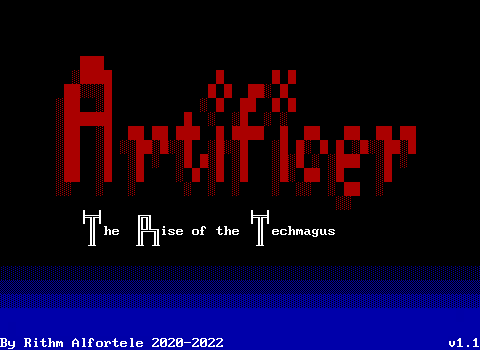Time for world chosen for it's somewhat short size. The previous article took a look at Nature's Revenge, a game with a compelling opening that mostly kept my interest going through it's unusual aggression displayed between friendly characters. That game was about going out into the forest and taking revenge on those who destroyed your village, and it managed to make its protagonist and NPCs so unsympathetic that it was a lot easier to root for the monsters, who were far more sentient than the humans of the game seemed to acknowledge.
I spent more time just exploring the starting town than I did actually seeking revenge. The game didn't really work super well.
So I tried my luck with another short game immediately after, selecting Wizard's Apprentice with it's cute title screen and author that was unknown to me (although I apparently did stream a demo of one of the author's other titles at some point). This time I had more success in getting something worthwhile. There's not a whole lot of comparisons to really be made between the two, their similarities are fairly universal ZZT experiences. You spend a lot of time in town, and surprisingly little time in enemy territory.
Wizard's Apprentice uses a similar format of being heavily focused on the town, this time with the player's actions feeling actually important as opposed to Nature's Revenge boiling down to talking to people for the sake of talking. The two are dated a few years apart, but pair together surprisingly well. The experience here feels so much more cohesive, even if it has its share of rough spots too.
An unnamed protagonist whose master has gone missing leaving only a cryptic note to seek the wise one to the north makes a stop in a small town sensing something to be amiss. Something that probably originates from the shadowy fortress looming over the town. What unfolds is a beginner level adventure of righting a few wrongs, learning the ways of magic, and of course putting up with some angry skeletons. It's short, it's sweet, and unlike Nature's Revenge which left me wondering what I just played, this one is a solid example of how even a newcomer to ZZT can still be a source of genuine entertainment.
So join me as we take a look at Wizard's Apprentice, it's unusual structure, it's admirable hero, and it's many troubles that hold the game back.
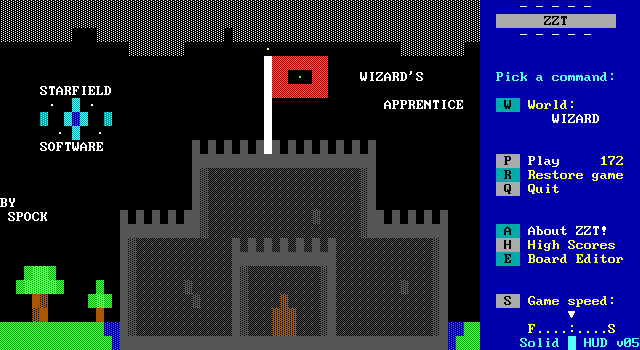
Open-Ended Gameplay
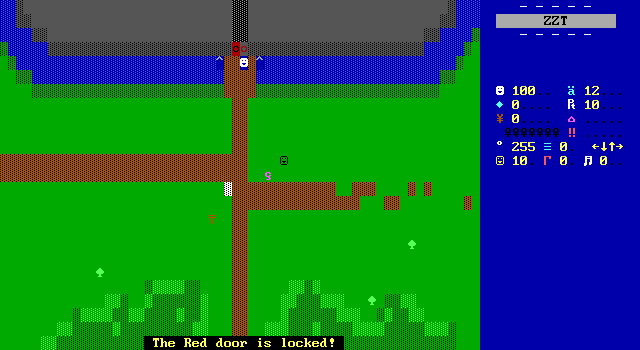
From the very beginning of Wizard's Apprentice, nearly the entire world is open to the player. This world isn't exactly huge (this isn't Adventure 2 or anything), really focused on just a village, its farmland, the outskirts, and the fortress itself. It makes for a tidy experience where much of the game is about figuring out where to go next with new items and abilities as you receive them, and little time being wasted for those whose wandering is a bit more aimless.
For a fantasy-themed game, this makes it seem rather unique in taking place in what would usually be a peaceful place rather than a hostile one. Obviously ZZT is no stranger to dangerous towns what with Town of ZZT and all, though usually the danger is manually injected into such games as part of turning a real world analogous space into an abstract environment fit for ZZT's moving and shooting. The park in City of ZZT has a pride of feral lions that stalk it which requires no explanation as players immediately see it as something to engage with.
Meanwhile over here the town is trying to appear as a war zone under occupation by a tyrannical wizard's army of skeletons. Lions shouldn't be roaming in your local city park, nor should skeletons be scaring the populace. With Wizard's Apprentice, the skeletons being defeated means a return to normalcy for the setting. In City, those lions in the park are what's considered normal to the setting.
The city under siege almost makes the game sound like a more fantastic take on the gritty crime-ridden ZZT cities commonplace in the early 2000s. These type of games were on the rise already, but became particular commonplace after Grand Theft Auto 3 had an impact on gaming so large that even ZZTers felt compelled to emulate it as best as they could. Games like Thug Life (and especially its sequel whose demo uses a very GTA styled title screen), The Thief 3, and Burglar! were seemingly everywhere.
Fortunately, the dire situation where many these games have aged quite poorly isn't something that applies here. At the time of the game's release in 1998 the 2000s era edgy vibe wasn't a thing at all, and the ZZT community's equivalent to GTA in terms of shock value Teen Priest 2 was more than a year away with its tamer first entry still a few months off as well. The only things players need to stay on guard for as they explore homes and farms are skeletons quickly tamed by a finger gently resting on the shift key.
All of these locations could, would, and should be peaceful, were it not for this invading force which makes the effects of the town's subjugation apparent without any need for narration, though there will be plenty of that to put together a proper story. Wizard's Apprentice may be the first game I've played with this extremely commonplace setting that manages to avoid all the common places you'd expect to surround it.
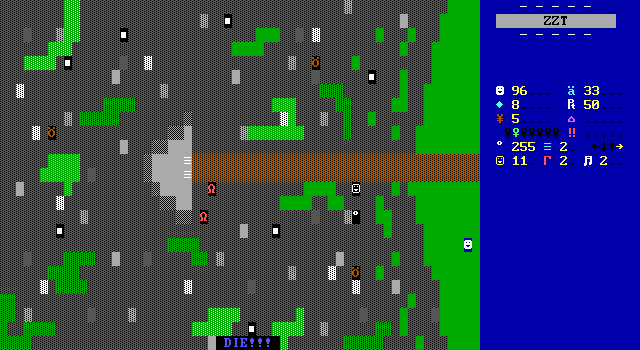
See those mountains? You can't climb them. The western cave? As soon as you step inside you're in the home of its occupant, not a lion or tiger in sight. There are no forests, no coastlines, no mines, no swamps, nothing. The game is squished down to fit only the essentials, skipping over the typical travel found in meatier adventures like, well, Adventure. The adventure here is scoped to a much smaller environment that can be crossed in short time, and the stakes, while real, likely won't lead to the world ending should you fail in your quest. This is a Pathfinder module designed for a level one wizard. Outside of the fortress just a minute away from the town tavern, the only thing close to the kind of dangerous environment you might expect to find is the badlands, a single board west of town that sprinkles a few enemies around.
And it ends up working out for the best. Wizard's Apprentice creator Spock's release history is barely a blip compared to more prolific authors, with this game as their first release, a sci-fi action game released in the following month, and then a demo for a more grand sci-fi action game the following year. The game doesn't give me the feeling that Spock opened the editor for the first time and immediately after closing it sent the game off to be published somewhere, but its flaws (and bugs) definitely point to the game being Spock's first serious foray into ZZT. It's an admirable effort, an encouraging first step on a ZZTing journey that ultimately didn't go particularly far. Beginner or not, there are plenty of fun moments to be had, and some original ideas to be found here. Just don't go expecting a classic.
A Town In Need
The player's motivation for helping the town out is nothing more than being a good Samaritan. Upon arriving in the town on your travels, there's a clear air of oppression, thanks to a dark imposing fortress that looks over the town. The villain here is a petty tyrant of a wizard with a bit of an ego problem who goes by Karrik.
Karrik isn't all bark. He is a powerful wizard himself, far more powerful than the apprentice protagonist. His power stems mostly from a magical cauldron used to summon an endless number of skeletons that obey his every command. These grunts are the main foe players have to deal with in their attempts to free the town. While obedient, these skeletons aren't mindless (...they probably are physically though). Fans of Warlock Domain will recognize some similarities between the games' skeletal foes. Both generally aren't hostile to the player until provoked, and often times players can attempt conversation with them.
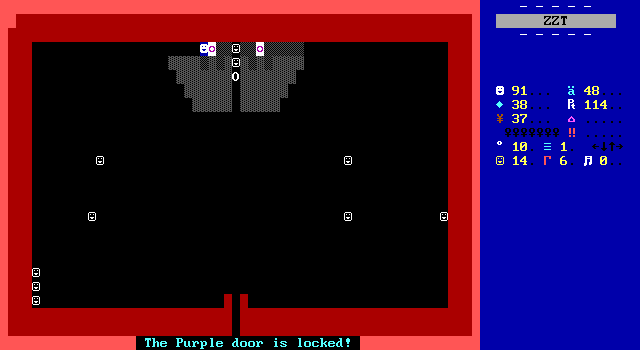
These skeletons don't serve as comic relief as they do in Warlock Domain. There, the skeletons are a core part of the game's humor, while Wizard's Apprentice needs them to be threatening in order for them to strong-arm any dissenters in town. If a skeleton isn't a special NPC with a specific purpose, they all spit out the same generic conversation when talked to about worshiping Karrik. As someone with such fond memories of Alan Chan's game, the universal dialog compared to the immense personality of the skeletons in Warlock does make the game a bit disappointing as it's been established that you can do wonders by allowing players to talk with enemies even if there's no possibility to settle things peacefully.
That being said, there's nothing to confirm any connection between the two games. Spock makes no mention of the game as inspiration, and the stories diverge significantly enough that any similarities may be chalked up to coincidence. Still, the several years between the two releases make it easy to see Warlock Domain guiding the ideas here. The game is a bit of a poor man's Warlock Domain, albeit one unique enough that it would be unfair to write this one off completely due to its counterparts overall better execution.

The hunch that something is off around here is quickly confirmed when the very first NPC players encounter is a skeleton standing outside the fortress's entrance, with the body of a human not far from him. Players receive the skeleton's side on the matter. The great Lord Karrik has blessed this town with his presence, offering salvation to the inferior beings. Salvation in this case meaning a life of slavery. A diary found later fills out the backstory with a bit more detail, revealing how the initial arrival Karrik went down, and why the populace quickly opted for this salvation.
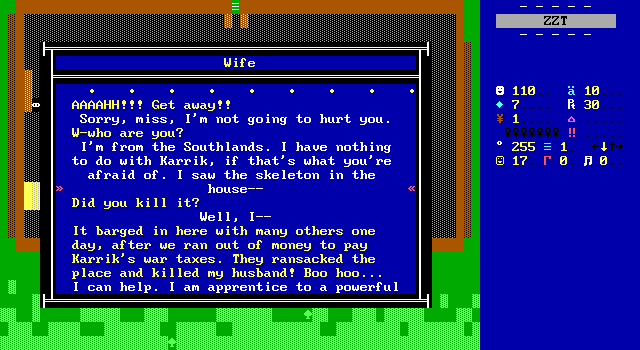
Of course, the villagers see things a bit differently. For as powerful as Karrik may be his skeletons can't be everywhere at once. Any villagers left alone are more than happy to complain about Karrik and his demands. As the story progresses, the villagers reveal themselves to be more than just helpless victims. Having a magic user in town willing to help is a blessing, but with or without the player, plans are already underway to free themselves from Karrik's rule.
Mastering Magic
The protagonist is eager and willing to help out however they can. Magic being a core part of that. At the onset of the game, the only ability players have access to is a weak fireball spell. This spell is simply ZZT's shooting mechanics, with ammo being accrued by collecting pouches of fire magic found scattered around the village. Upon discovering the Wise One named in your missing mentor's note, players gain access to a small library of spells. With your current lack of experience, not all of these magic spells can actually be learned right away.

The game gates magic between three levels of experience. While some ZZT games opt to incorporate experience points, players will quickly discover that Wizard's Apprentice keeps things simple. Experience increases at specific points in the game. Certain actions when finally performed will mention gaining experience. Though the game's map is open, the actions players can take at any given point are not, with only the earliest portion of the game giving players options on what to do. As tasks are completed, the path gets narrower and narrower.
The list of spells and the required experience to learn them is bizarre to say the least. It's to the point that the game might have been better off ditching the framing of experience and opting for something like finding missing pages in a large tome. In fact, one of the spells even does have a page missing when you're finally able to learn it, requiring an item to be found to be able to mend the damaged book.
As for the spells themselves...
- Morph - Used to transform the target into something else. Requires advanced experience.
- Destruction - Used to destroy anything except for walls and water. Requires advanced experience.
- Basic Opening - Used to unlock non-magical locks. Requires minor experience.
- Advanced Opening - Used to unlock magical locks. Requires medium experience.
- Raising The Dead - Used to revive the recently deceased. Requires minor experience
Yes. In this game bringing the dead back to life is as basic a spell as opening a locked chest.
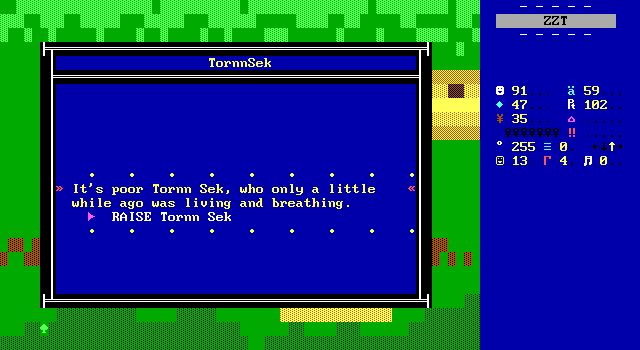
The spells themselves take the most straightforward approach to implementation as well. Given how rarely they're used, this makes sense. Going as far as to have players open a spell menu as they would in Ultima RPG would be way too much work. Nearly every spell in the game is only used once, with at most a spell being needed a second time.
The option to use spells anywhere only for them to be ineffective 99% of the time would very much be a waste. Where there is some room for improvement, to me at least, is in how Spock uses keys as part of the spells. The unlocking spells just give players certain colored keys on the spot, something that might work out alright provided there's just one door of that type to be unlocked. The setup is more annoying since Spock uses flags throughout the game just fine! Just spawning in a key feels like something you'd see someone with only the most basic grasp of ZZT-OOP do.
The use of keys is harmless the first time, but needing to use the advanced opening spell a second time asks players to make a second run to the wise one's library in order to be able to use it a second time. This is exactly where using flags would shine. It's more effort to program up a door when ZZT provides, but what ZZT is providing here isn't the key/lock system that the game wants to use. As if via some cruel monkey's paw wish, players do get to avoid having to make multiple trips for this spell, thanks to bugs preventing it from working right in the first place!
Key Problems
Sadly, Wizard's Apprentice is far from being free of bugs. It cannot be completed without cheating multiple times in order to get past certain obstacles due to issues with the code. It's enough to make it difficult to recommend the game, which otherwise, was enjoyable. When things are working the experience is smooth. When things aren't, it leads to some messy digging through code to due to the open design of the game. When you're supposed to be getting a key and don't, it turns into a fiasco to figure out which of the numerous keys you were intended to get at a specific point.
The bugged spell in question is advanced opening. Rather than provide a purple key, it provides nothing. Not even a flag is set for this one, making it a very odd oversight. Twice players will have to manually zap past purple doors, and that's far from the only trouble they'll run into.
There's a second key which can sometimes cause the game to break. One of the villagers has a lock-pick players can acquire which is also handled by handing out a key. The key is always placed north of said villager, a tile that's adjacent to a wall. If the player talks to this villager from the north, there's no room to push the player away and the key won't spawn, though the villager will assume it has and move to the next set of dialog when touched afterwards.
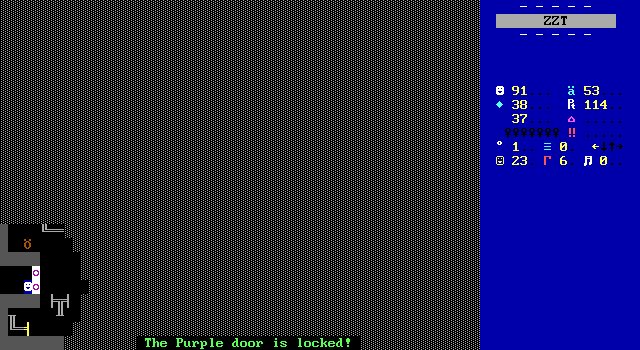
The key and door situation in this game is difficult to figure out. The lock-pick is described as being necessary to break into Karrik's cauldron, which has a purple door. The lock-pick provides a red key. The advanced opening spell provides no key, and has to be intended to provide a purple one as the lock-pick is a one-time thing while the spellbook provides multiple copies. A second purple key is needed to enter the fortress's treasure room.
As for a red door, the only one there is the entrance to the fortress itself, with the key being purchased from one of Karrik's skeletons. I'm not sure if the lock-pick is meant to be an alternate way in, since it is possible to overspend on gems and be unable to buy the key, or if one of the purple doors was supposed to be red. This could very well be the first instance of squinting at ZZT door colors causing problems for the game's author and not just the players!
Oh, and if that wasn't enough, another spell can also become unattainable. In order to mend the missing pages from the destruction spellbook, players must first find a missing piece of a healing staff (used to heal items, and not people apparently). Once you use the staff on the book text is displayed indicating it's been fixed, which I took to mean it was time to touch the object again to properly read it. What you're meant to do is wait for a few seconds and then automatically acquire the spell as there's a delay inserted in the code between the "book healed" and the "spell acquired" messages. A label is zapped before the delay though and the object doesn't lock itself from other input, so touching the spell a second time will cause the object to try to jump to the wrong label.
It's just an unfortunately rough game sometimes.
The Great Hope
As the player, your first task is finding a way inside the fortress. The game puts players on the right path to this thanks to the "friendly" skeleton that's willing to sell them a key. From the start, your immediate goal is effectively to find twenty gems scattered around the town. This is easier said than done as gems are quite rare, usually being given in very tiny amounts unless you stumble upon an actual secret stash.
Since this goal is made known to players so early, the process of finding them is a lot less tedious as exploration in the name of gems doubles as exploration in the name of seeing what the world has to offer. Most of the village's buildings can't be entered, eliminating the unwanted possibility of the game being in the style of Gem Hunter where players need to explore everything everywhere in order to make progress. The streamlined design instead limits players to interiors that have a purpose for the game.
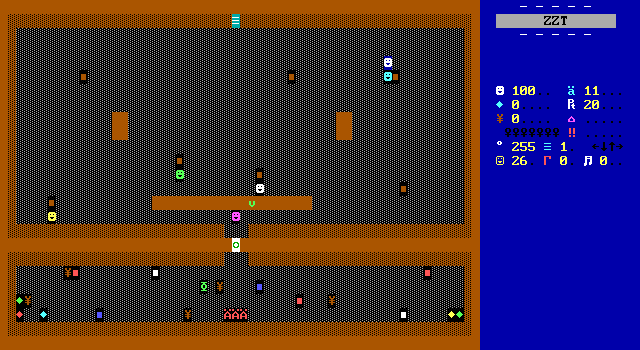
Rather than have to walk into every home to talk with one person per board, Spock avoids committing too much of the players' time towards speaking with an assortment of unnamed townsfolk with nothing to say other than "Karrik bad". Instead, villagers congregate in two places, the local tavern and the back alley behind the village.
It's the latter that ends up being the most important. After saving a woman whose husband was killed, players are led to a secret meeting place where a rebellion is being planned. The plot to bring down Karrik is having some trouble finding its footing. Its original leader has been killed, which certainly will slow things down. Luckily, the new leader, Tornn Sek has been finding some successes. Thanks to a magical item acquired from the wise one, or "the Wiz" as the villagers all refer to him, he has managed to kill a skeleton, creating the first casualty for Karrik's army.
The player has some thoughts on celebrating too early, voicing concerns that the skeletons seem to be able to communicate with one another telepathically, and if one dies the others will be quickly alerted. Sure enough, a skeleton crashes in on the meeting soon after, with Tornn leaping into action to save the day.
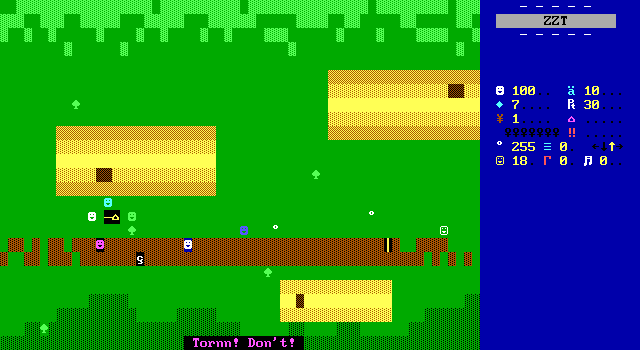
It doesn't go over very well. The skeleton shoots some bullets as they approach and Tornn is struck and killed, along with another member of the rebellion caught in the crossfire. While the others look on in horror, the player gets to use their fire magic to save the others.
I found myself really impressed with the way this scene was put together, and consider it to be the highlight of the game. The board felt like a safe spot for players to be introduced to several characters. The skeleton's arrival is unexpected, as was Tornn being killed as soon as he was introduced. The real highlight of the scene is the dynamic nature of it. The board is designed with the expectation that the player won't react fast enough to beat Tornn to reaching the skeleton. However, players can take a bullet on behalf of the other villager, effectively saving his life.
Not every possibility is handled however. If you know the skeleton is coming you can position yourself so that Tornn pushes you ahead of him, preventing him from being shot, however his sequence is scripted and he will act like a corpse when talked to afterwards, with the bullet only serving to change his appearance to a crumpled up . Letting the skeleton run free for long enough that other villagers can be shot also has no effect. Only Tornn and the villager named Darj can be saved, and Darj is also expected to die here, only ever bringing up dialog later in the game if he's been revived.
Even so, the scene got me good. It all works thanks to the raise dead spell providing the ability to dramatically kill off characters without actually having a permanent effect on the game. Depending on how players explore the world, they're likely to not even know about the spells that they'll eventually get making the deaths feel permanent right away.
A Conjurer That Cares

Wizard's Apprentice includes a few "extraneous" boards to create the sense of a larger world, and a greater journey for the protagonist. The game begins on one such board, placing players on the opposite side of a bridge that was crossed before the game began.
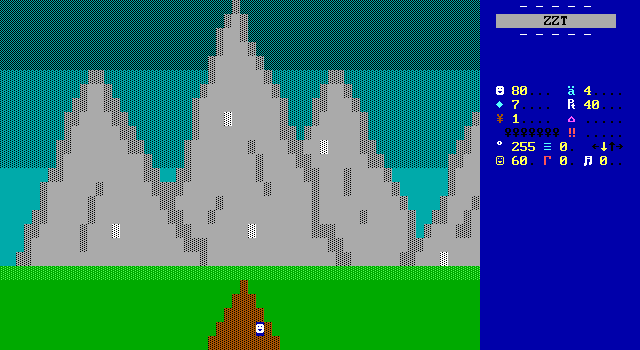
This later board depicts a road leading out of town leading towards a mountain range in the distance. ZZT boards frequently shift the game's perspective to suit their needs. Here, as is often the case, boards that have nothing to the north cut the playable space off to a limited number of rows from the bottom, using the extra space that players would have no need to walk on as a proper background. Both of these boards could have easily not been added to the game, but their presence provides some insight into the protagonist's personality.
While neither board offers an exit in gameplay, they do offer one in-universe. At any point, the protagonist is free to leave this village he does not belong to. He can go anywhere he chooses, but he opts to stay and help. Despite his lowly status as a wizard in training, it's clear that he wants to help those in need, even if he may not be up to the task. It's a reminder too that the player's assigned quest is to found the wise one and train with them. Prior to actually meeting the wise one, helping the village is something the protagonist does because they believe it's right.

You can see this as well in the eastern fields. Karrik may be good at subjugating the village, but he's abysmal at management. Every villager now works the fields as a slave, resting at the tavern, and living in fear. Yet only two villagers can actually be found working while the others are off doing their own thing.
The field is currently being used to grow plants used for making torches. One of the workers that's farther away from the slaver skeleton is willing to covertly give you some of the crops, but only in exchange for some gems so that he can feed his family. Given the need to get twenty gems to get into the fortress normally and the challenge of finding gems, with only thirty-one to find in the entire game (prior getting into the fortress), it's very much possible for a kind-hearted player to do the right thing and end up struggling to find a way into the fortress. The lock-pick is an alternative, but it takes some time before players will know it exists. Finding those hidden gems requires double-checking various objects, and there's also the challenge of not spending your money at the bar on health restoring drinks (which are admittedly not worth it) or buying torches from the bartender instead.
The option to help out even if it makes your own quest that much more difficult, makes the protagonist in Wizard's Apprentice that much more outstanding a person in my eyes. It wasn't until I finished the game that I realized that there even was a way inside the fortress without the money. (Admittedly this was more due to the weird bugs with keys the games had than anything else.) There are opportunities here to help out in ways that are much more mundane than dealing with a tyrant wizard, and that's a feeling you rarely get in ZZT or games in general, with most settling on direct rewards for doing the right thing. Torches are a lot easier to come by, and very few boards are dark. This purchase feels like it's included more to give players one more opportunity to be kind and not just a special bargain versus buying torches from the tavern.
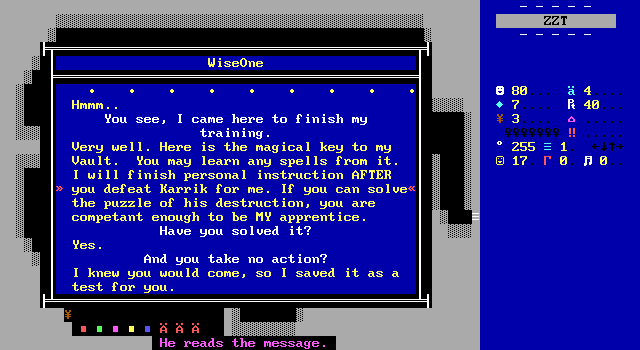
This sense of justice shines in one other interaction, perhaps unexpectedly. Once the player discovers the Wiz and requests training from him, he seems to be taken aback at the wise one's demands before training can commence. The wise one requires the player to find a way to defeat Karrik. The player asks if the wise one knows how to defeat Karrik himself, and when he receives an affirmative response, immediately (and politely) questions why hasn't done anything to help these people.
There's an endless number of games out there with "chosen ones" and "prophecies" and anything else to make it clear that one and only one specific character can save the day. Wizard's Apprentice isn't one of them, and it espouses a belief in being the change one wants to see in the world. The wise one explains they haven't acted because they knew the protagonist was going to arrive and thought it would be a good test of their abilities. Meanwhile, for the protagonist, the moment they realized this town was suffering, finding the wise one Zamal spoke of stopped being important, save to make it easier to help the village out.
Any real tension to the scene is reading into things that aren't there, but I can't help but respect our hero for bringing it up. People have been killed, and over the course of the game a few more die as well. Mind you that the revive the dead spell requires corpses to be still fairly fresh. This isn't a case where once Karrik is gone everything can return to how it was before his arrival. Having a powerful wizard that's a bit of a recluse hardly excuses the lack of action. At best, the wise one has only just now come up with a plan, but if he's just been sitting around doing nothing, it's no wonder the villagers are attempting to take matters into their own hands.

In fact, there is a slight acknowledgment of to the tension between the Wiz and the people. Tornn explains that the strange stick he was able to use to destroy a skeleton came from the Wiz, but paying close attention to the specifics shows that the Wiz wasn't exactly eager to help. It's mentioned that the town drunk Wassol sought out the Wiz and came back with the stick. Tornn states that Wassol didn't say anything about the item itself. At the time, nothing seemed amiss about this. The Wiz is known for being a hermit so giving the guy a magic tool and getting him out of his hair seemed reasonable enough.
Later on the stick is revealed to be the missing part of the Wiz's healing staff. The Wiz himself explains how it came to be in the hands of the townspeople, and describes it as having been stolen. Suddenly it all makes sense.
It sounds like Wassol tried to get help from a powerful wizard to defeat an evil powerful wizard and got turned away. Not wanting his people to continue to suffer, he took part of the staff and delivered it to Tornn, acting as if the Wiz had given it to him.
It's such a small detail, that wouldn't have changed my perception on the game had it not been included, but I just love that it's there in the first place. It's something you can catch if you're paying attention, even if it doesn't matter in the end. For the protagonist, there's a missing piece, and once it's been found it's returned, no questions asked. The game never draws attention to it, letting players make the connection themselves, and if they don't, that's okay too. Spock does something unique here by letting you into a little bit of community drama without turning it into the player's problem. There's no need to pick a side, just take the stick and move on.
Cracking Skulls
While the game offers plenty of skeletons to blast away to dust with your magic, the action really takes a backseat. The focus is placed much more on exploring the village and its surroundings, finding people that need something to be done, and collecting a reward when you do so. In that sense the game plays more like a point-and-click adventure where the protagonist has a gun. This setup is commonplace in ZZT, where the engine is best suited for games that offer a variety of gameplay styles rather than stick to a single idea for the full duration. Primarily because action in ZZT tends to be repetitive and basic. Going back and forth between looking for items and fighting off enemies keeps things from getting stagnant, offering valleys and peaks in excitement instead.
Although the game opens by emphasizing the player's ability to use a fire spell as a weapon, nearly every enemy in the game can be ignored by just running past them. Of course, the game also mentions using it as a tool, and at no point in the game do you use your fire magic to ignite something that isn't an enemy. That so many skeletons won't even be hostile initially doesn't help make the action any more intense. You can get in over your head if you start firing wildly in the fortress where boards have dozens of them running around, but by the time players get inside the fortress it's been well established that keeping your hands to yourself will let you wander in relative safety.
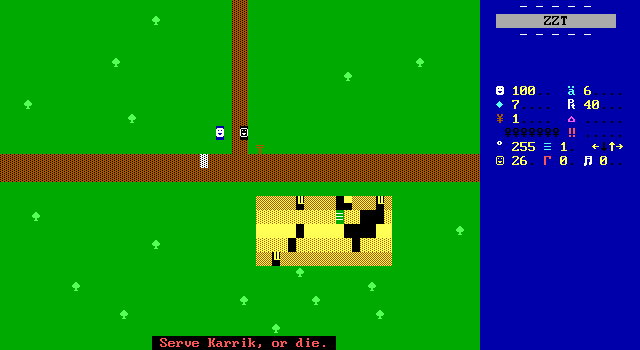
Every hostile skeleton behaving identically doesn't do much for the combat on that front either. It gets tiresome quickly and offers no tangible benefit. Perhaps if villagers kept their mouths shut about Karrik when skeletons were present in a room there would be some motivation for players to liberate the village one board at a time. Really though you're much better off enjoying the more appealing aspects of the game, talking to the villagers, tracking down gems, and looking for opportunities to use your magic spells as you unlock them. Not to mention, the player does liberate everyone eventually. Rather than conquer the army piecemeal.
Rarely, the game will acknowledge that maybe something other than a skeleton can be a threat. The badlands west of town that lead players to the wise one's cave goes classic ZZT, with just a single skeleton off in the corner while using lions and bears instead. A place like this makes lots of sense to use the numerous beasts of ZZT. You'll also run across them in the fortress itself, though in extremely small numbers. Had the halls been a little more packed with enemies players can't get away with ignoring, and you could wind up in a tense situation where one badly placed shot activates one of the skeletons who begins shooting wildly, agitating more skeletons in the process.
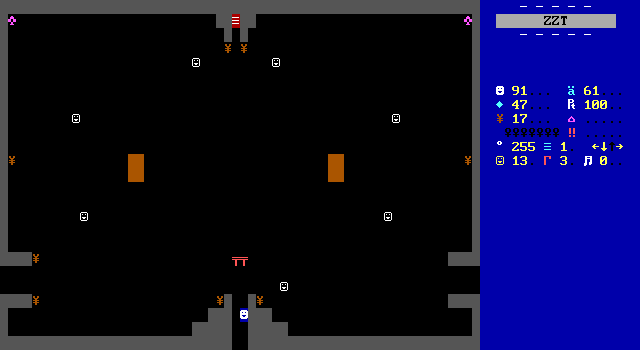
That's very unlikely to happen as the number of non-skeletons is just so minuscule and the room is wide open for players to keep their distance.
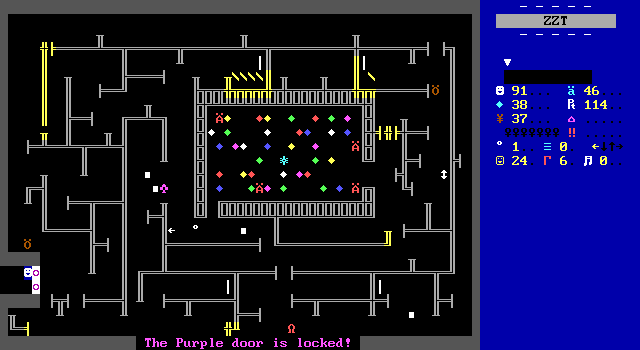
The treasure room does show us what Spock can get up to when designing a board to cater to old-school design, putting together a dark maze with lions, ruffians, bears, blink walls, and a spinning gun. It's easy to look at the game's struggle with action and put all the blame on the skeletons, but this really isn't any better. Spock seems to have difficulty making action scenes with oomph, throwing players into a mess of linewalls that is still unable to be threatening in any way.
I wouldn't consider this a failure. The game isn't really trying to captivate players via action, and the other components of the game are much stronger. It may just be a case of shooting being such an expected part of ZZT games, especially in the 90s, that Spock didn't want to go so far as to have a game devoid of shooting entirely. The only thing players really notice about the combat is that they sure are getting a lot of ammo that they'll have little interest in using. There's no big payoff here.
There is still the matter of dealing with Karrik once players finally reach the throne room. Surely, there's going to be a wizard duel in which Karrik's defeat marks the end of his rule, right?
I'm afraid not. A player that's unprepared or has a death wish can challenge Karrik once they make it inside the fortress. Despite being ineffective at taking him on directly, the feisty apprentice will still talk a big game about training under the great Zamal. Karrik isn't impressed, making it all but explicit that Zamal was killed by Karrik. This doesn't deter the protagonist who continues to make threats which Karrik takes as a formal challenge resulting in the two doing battle.
The fight isn't exactly fair, if the skeletons haven't been destroyed, they'll also get involved, throwing stars while running directly at the player. Not that having them destroyed makes the fight go any better. Karrik can't be harmed by your weak fire spell, and that's the only offense available. A different approach is needed, as otherwise initiating the fight is a game over in everything but name. ...Unless you touch Karrik a second time. His code doesn't stop you from restarting from the original text prompt.
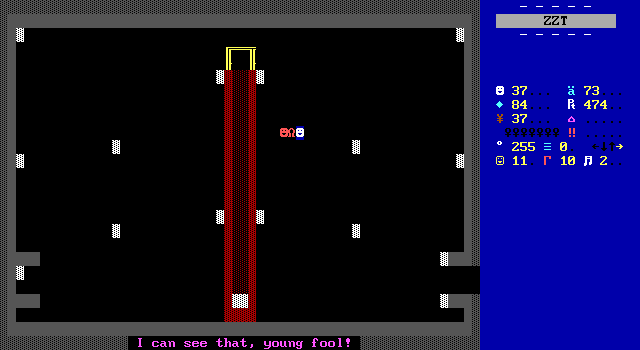
Instead of fighting, having some alternative spells lets players choose to try them out on Karrik rather than talking to him. The obvious answer of the Destroy spell is foiled quickly by Karrik who is always ready for such an attempt on his life. The bomb produced by the spell is morphed into a lion causing the player to be the one harmed instead.
To actually free the town from Karrik's rule, players will need to come up with a more discrete method of bringing the tyrant down. Rather than have a wizard's duel with colorful magic exploding everywhere, the game turns the final fight into one last puzzle. It's not exactly difficult to figure out as the list of spells is small and only a limited number are even permitted as possibilities when interacting with Karrik, so you won't exactly feel brilliant for figuring it out.
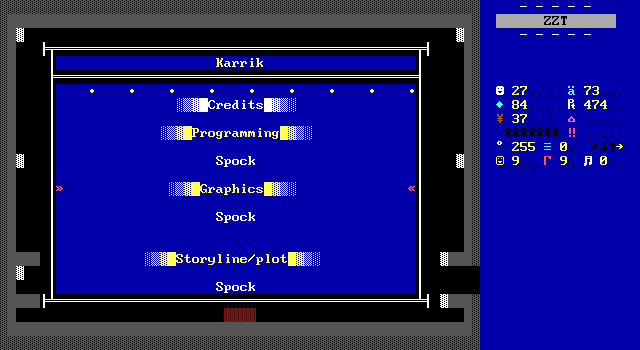
At least the people are appreciative. The game wraps itself up rather quickly. There are no dedicated boards to show an ending or the game's credits. All of that stuff is handled by the Karrik object, so the moment he's defeated, everything is over. Things end with the wise one's promise being kept, and the player going on to receive training under their new master. The fortress is "redecorated" and turned into a castle ruled by Tornn Sek who has been made king. It wraps things up nicely enough as the game isn't exactly loaded with plot threads to resolve.
In the end, your final action of the game is to choose something from a menu. That's hardly an exemplary demonstration of what ZZT action titles are capable of. For those that make it to that point though, there won't be any disappointment. Wizard's Apprentice knows it's no action game, and players itching for something to shoot will have long since moved on. For those seeking entertainment from ZZT that doesn't rely on bullets, there's plenty of other things to enjoy instead.
Final Thoughts
This one was plenty of fun to run through. I really enjoyed seeing where the story went, and enjoyed the Tornn Sek death scene. It was a pretty short game with very little downtime. Things kept moving throughout. I remained curious what I would gain access to with each new spell and always felt like there was something I had yet to try.
At least until the bugs started kicking in. They really do spoil the experience with how much things slow down when the game turns into an exercise in debugging. It's hardly uncommon to have to cheat to get through ZZT games, whether that be due to a lack of supplies, or coding error. I hate to act like opening the cheat prompt means a game can't be enjoyable. ZZT's basic cheats allow so many games created by inexperienced developers to be finish-able, and these games often have something about them to hold one's interest. Needing to look through the game's code however, is far more difficult to justify. The fact is I had fun here. It's just always hard to recommend a world that requires reading a list of issues and ways around them in order to reach the end.
Were it not for the bugs, it would be a lot easier to make a judgment on. It would still very much be a game with clear marks of being somebody's first ZZT release, but the game's lack of complexity shouldn't be seen as a detriment. It's not the most exciting game out there. Again, Warlock Domain has a similar vibe with much better presentation, humor, and just quality overall, but you can't have too much of a good thing. Fans of the ZZT fantasy adventure can still get something out of the game, bugs or not, though I doubt the game will be remembered for too long after finishing it.
What could have been a promising start stumbles right out of the gate, bringing a reasonable way to spend your time into something a little more questionable. I wish I could speak better of Wizard's Apprentice. I wound up playing the game (short as it is) in halves, and was looking forward for the next day to finish it. Compared to Nature's Revenge, this is definitely headed in the right direction. The trouble is that everything "wrong" about it is pretty easy to make right, leaving the game with some glaring issues that leave me with no regrets playing it, but not motivating me to rush out and convince everyone that they've got to check it out themselves.

